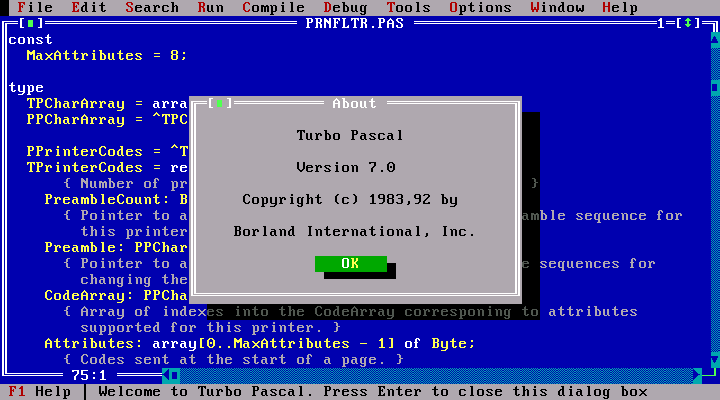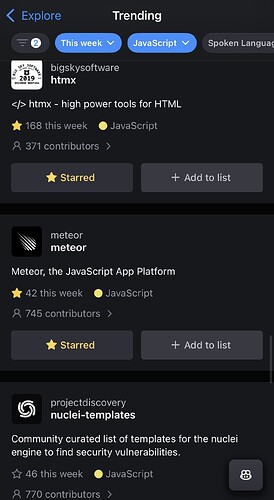Hello, @edemaine and I are both on the Solid.js team. I’ll share some opinions on what I’d like to see for a framework like Meteor (or a Meteor-from-scratch-like project):
- standards aligned
- Custom Elements for the view layer (standards aligned) (I explain why further below)
- everything would be able to run with vanilla ESM (on the server and in the client) and zero build (standards aligned) out of the box. No transforming any code, no compiling anything, just simple code that runs natively on both server (Node.js, Deno, or etc) and browser.
- optional build steps can be used for optimization, but not required.
- Optional build steps would be needed for things like bundling for Apple/Google stores, or for bundling Electron desktop apps.
- Other optional build steps would include minification, TypeScript, bundling into a single JS file, etc
- It is better to start with vanilla buildless to avoid all the issues that build tools can cause. Then, when people opt into those tools, they always have a buildless fallback that would at least always work without problems.
- the client would be fully static by default (because ESM and standards aligned) so it can be served from Meteor or easily deployed to any other static file server separately without build-tools.
- full stack reactivity with Signals and Effects (i.e. Tracker, but the reactivity on both server and client is needed for a great DX (instead of Promises on backend and reactivity only on the client))
- Meteor specific: accounts, roles, and CMS in a default template (thinking “posts” and “pages” like WordPress out of the box)
- Meteor specific: very simple control of real-time throttling speed. Real-time is an awesome default, but not everything needs to be sync’d as fast as possible, and it is not obvious to people how to throttle the sync speed currently (which led to many people complaining about Meteor’s performance because they have no idea how to throttle data).
- Meteor specific: official schema system for Mongo documents
These ideas are fairly high level, not too specific about Meteor, except that last three, in that I think having a high-level template with all the bells and whistles of a full app (that if you veer from this default makes things more difficult for yourself, which is fine) would be great and would help many people build apps more quickly.
React is not a good option because it is the last framework that does not have signals and effects, like all other major frameworks already do, inspired by the movement Solid.js created. React is “legacy” in my eyes because they do not even care to ship ES Modules in 2025, instead they ship CommonJS which does not even run in any browser without a build step or a CommonJS shim for the client-side. VDom diffing has already been proven less desirable compared to fine-grained updates (signals+effects these days). React’s state system is locked into the component system and cannot be used outside of it which leads to the requirement for 3rd-party state systems that introduce entirely different paradigms than the state that is inside components.
Solid.js Signals and Effects are very similar to Tracker and ReactiveVar, so they fit very well together. In fact, @edemaine’s edemaine:solid package makes it so that Meteor’s signals (ReactiveVars) work in Solid without any manual integration, making the experience feel very natural. Solid’s Signals and Effects, just like Tracker and ReactiveVar, are not limited to being usable only inside components, and can be used entirely on their own.
By extension, this means that Meteor’s signals also work in @lume/element which is built on Solid.js when using edemaine:solid.
We’ve also been developing a lot of high-level signals+effects primitives over at Solid that lead to very nice and concise clean code, that we could help bring over to Tracker+ReactiveVar. They are so similar that you can do this to get the same API as Solid.js equivalents:
const {
autorun: createEffect,
nonreactive: untrack,
onInvalidate: onCleanup
} = Tracker
function createSignal(initialValue) {
const var = new ReactiveVar(initialValue)
return [() => var.get(), val => var.set(val)]
}
// Now use it just like Solid.js:
const [count, setCount] = createSignal(123)
setInterval(() => setCount(count() + 1))
createEffect(() => {
console.log(count())
untrack(() => {...read other signals without tracking...})
onCleanup(() => {... runs when the effect is stopped or will re-run})
// effect nesting works the same (and this, is powerful, and we need it on backend too)
createEffect(() => {...})
})
If you find any articles on “signals and effects” they all apply to Meteor Tracker+ReactiveVar too, just differnt naming.
The TC39 Signals proposal aims to bring Signals to JavaScript natively. (If TC39 Signals comes out, with some minor changes Tracker+ReactiveVar will be in standards alignment here which is awesome!)
The reason I am biased to Custom Elements is because they are a standardized UI component system. You get devtools integration in all browsers out of the box (element inspector). This also means that if at any point in the future the Meteor team woud like to change the implementation of a hypothetical <accounts-ui> custom element, they could do so without everyone having to change their UI framework, without breaking changes. For example, a hypothetical <accounts-ui> element could be implemented with @lume/element, or with Svelte, or with Lit, or with anything else really, but it wouldn’t matter to the user of the element who would see the same DOM interface after the update and their app would continue to work.
The @lume/element package has type helpers for hooking up Custom Element type definitions into all major frameworks, enabling type checking and intellisense in the JSX of React, Preact, Solid.js, etc, and in other template systems of Vue, Svelte, etc, all which are powered by TypeScript. The docs for cross-framework type definitions are here:
By writing a hypothetical <accounts-ui> element with @lume/element, Meteor would be able to guarantee that all other framework users (React/Preact/Vue/Svelte/Solid) would have type checking, autocompletion, etc, no matter which framework they use. At worst, it will work in all other frameworks without type checking. This is much easier than, for example, trying to write 10 different components for 10 different frameworks.
If Meteor were to go with Solid, then an AccountsUI component would need to be made for all other frameworks. This is where Custom Elements can really help out, and Lume Element is the first with type checking across all major frameworks.
If I were starting from scratch, I’d consider looking at the following meta frameworks to see how they implement their foundations (or adopt one of them as a starting point):
- https://astro.build/ - server-side rendering and static site generation (SSR/SSG) framework with empty backend, supports SSR/SSG for all major frameworks, and any other framework can plug in their SSR/SSG plugins to make their components be SSR/SSG-capable to be hydrated on the client.
- https://greenwoodjs.dev/ - Similar to Astro, but focused solely on Custom Elements and standards alignment. It allows any Custom Element framework to hook up their SSR/SSG functionality like how Astro does (but only Custom Elements, no plain React/Vue/Svelte/etc). Very cool.
- https://enhance.dev/ - Similar to Greenwood, but with a single opinionated way of writing custom elements. Enhance has the unique ability to run buildlessly as an option.
What each of these three frameworks do is create a very clean abstracted layer between backend and frontend that includes the tough parts (SSR/SSG and connecting UI components across both sides), then leaving the user to implement backend and frontend logic specific to their app. A Meteor-from-scratch-like project could for example take one of these frameworks, then add authentication, standard set of components like <accounts-ui>, and other higher level features.
Vite is often used as a foundational piece below meta frameworks (including Astro, SolidStart, SvelteKit, etc) because it supports standard ESM and tries to remain standards aligned, while adding plugins for supporting non-standard features such as importing from a .jpg file, and hot-module-reload.
SolidStart is a great option only for Solid.js-based components. Similarly to those other three frameworks, a Meteor-from-scratch-like project could take SolidStart and add all the higher level things on both backend and frontend to make a more complete experience (accounts, roles, database, etc). But such a project would then disclude all the other React/Vue/Svelte/Angular/etc users, while Custom Elements can make it work for everyone.
React user:
function MyComp() {
// ... JS code ...
return <div>
<accounts-ui ... /> {/*This is a custom element.*/}
</div>
}
Vue user:
<template>
<div>
<accounts-ui ... /> <!-- This is a custom element. -->
</div>
</template>
<script>
// ... JS code ...
</script>
Etc.
How could a Meteor-from-scratch-like project start (or what would Meteor moving to) look like:
- First, get everything running, without a build: all Meteor packages on server and client, natively. Once this is working, then we can incrementally add the rest:
- get native code working with and without Vite.
- take it a level higher, get it working with and without Astro.
- etc.
The key to making this work well is to start with a fresh fountaion built on standards (and making the decision to stay fully aligned with them as they progress). This means removing Meteor’s build system, no more ecmascript package which is now unmaintained and not aligned with standards, and when a build problem happens with it people get stuck. A downside of this is we may have to create a whole new system for packages that add integrations like Vue, or special modules types like import 'foo.mp4', etc. A big change, I know. I’m not sure how to keep the current build system (and the packages made on top of that) while having the new hypothetical design.
The good thing about being standards aligned is that the major hurdle, ES2015, we’re already past. From here on out it will be mostly just incremental language features, and nothing so major as the huge ES Modules update. So once we get over the hump of dumping the ecmascript packages and running natively, it will be smooth sailing.


